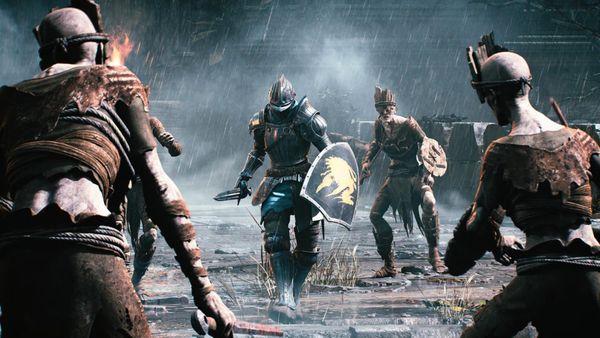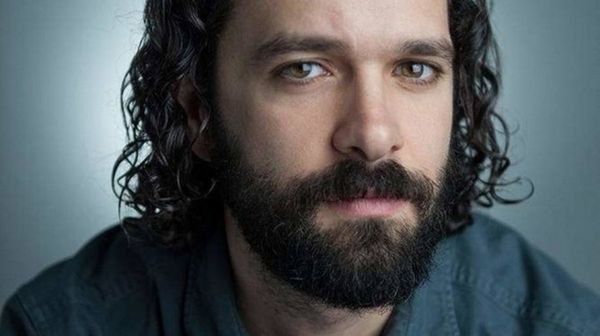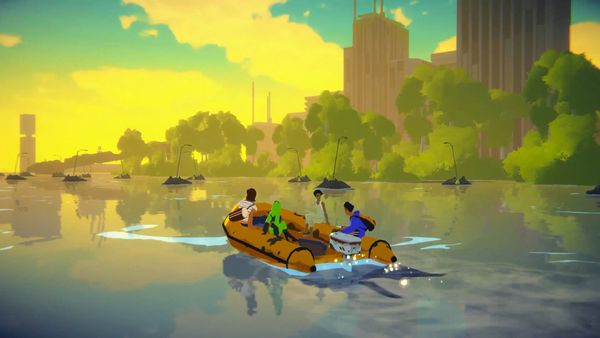Darkest Dungeon 2 Is A Road Trip Through Hell With Terrible Co-Workers
Inland Empire is David McNeill’s column about world building, CRPG’s, love, loss and many other kinds of literary vulnerability.
Ridley Scott once said that he avoided sequels unless there was something fresh to do. Some new piece of story to tell, some new part of the world to reveal. And he’s right: most sequels are often iterations on what came before. Different enough to be a new enough product with screws fine-tuned, the motor oil changed, a new lick of paint.
In video games this is especially the case. Annualised sequels from triple A studios aim to incrementally improve lighting, change the balance of this gun, or alter the set dressing. So that Darkest Dungeon 2 is almost a completely different experience than the original is refreshing, if conflicting. Darkest Dungeon 2 is not necessarily harder than the first, but it is different hard.
I’ve written extensively about the first Darkest Dungeon because the game resonated with me during a time when I wasn’t really playing games. When I wasn’t really doing anything, really. The gradual mastery of the game’s mechanics proved a challenge that unique paired with my depression and resulting ennui. Over the three hundred hours and change with the game, I came to understand every intricacy of the combat systems, world and narrative. Wayne June’s voice is etched into the grooves of my skull, so much so that even when I met him, all I could think hear was The Caretaker.
Approaching Darkest Dungeon 2 years after the first was surreal. The art style is new, 3D and dynamic, but also very similar. The animations are fresh, articulate, beautiful, but also very similar. The combat is tweaked, fine-tuned, with a stronger focus on stress and damage, but also very similar. The structure, however, is distinct. The effects of stress on the party are divergent. The focus of the game is now squarely on managing the relationships between your heroes on the world’s bleakest road trip through a blasted hellscape.

The first game’s structure promoted short, carefully planned dungeon runs as the main method of play. Each run you had the opportunity to purchase a number of recurring resources to assist in the run: torches for light, food for healing, status items for maintenance and so on. You would spend treasure to upgrade your heroes or town, slowly moving the dial on the challenges you could surmount. The majority of the game’s randomness came in combat encounters themselves. An enemy landing a crit at the right time. A bleed status being resisted by your hero. A boss roaming the halls happening on you.
Darkest Dungeon 2 has far more randomness in its structural proceedings, and for better or worse, it’s certainly full of fresh ideas.
A key mechanic in both the sequel and original is the flame - the basic idea is that your heroes are journeying through dangerous swamps and ruins invested with eldritch horrors, so keeping torches lit and a clear view ahead is necessary. As the light grows dim, your heroes struggle to see ahead, begin to jump at shadows, and grow more and more stressed. Enemies grow vicious in the blackness, afforded combat bonuses. Leave the torch unlit for long enough, and you’ll find you're not alone in the dark. Here there be monsters. And they be really fucking hard.

In the first game, you could buy torches before each and every run - the trick was guessing how many torches you might need for the run without buying too many. They’re not inexpensive and they take up limited inventory space that you may need for loot and bandages, or hell, the trinket you were out to collect. So when you ran out of torches and got jumped by a horde of enemies or watched a hero succumb to their paranoia, it always felt a bit like there was something you should’ve done to prevent it.
In Darkest Dungeon 2, however, the shops and hoarders you encounter on your journey have completely random items available. There’s no guarantee you’ll be able to buy the equivalent to torches at the start of a run. While there are Assistance Encounters during each run that allow you to increase your Flame level, there’s no guarantee you’ll run into enough to keep the level high enough. On top of that, the punishment for running out of flames is a Cultist encounter.
Cultist encounters in the dark are frustrating. Enemies spawn dodge tokens and increase damage tokens frequently and hit the deep ranks of your team hard, often killing your healers early and fast. They’re not impossible, and I’ve surmounted quite a few, rewarding the player with powerful trinkets unavailable elsewhere.
This changes your relationship with the flame. Rather than weighing up whether you should take another three torches, and regretting the decision as you get party-wiped by a cackling madman, you scan every tavern’s shop and immediately buy the torch combat item every time. There’s no longer an interesting choice here - just a dice roll, and an obvious outcome if you roll correctly.
And I think this is the real difference in the second game. The focus is truly on the relationships in your party - it is a long, trying road trip through a blasted hellscape where a single mental breakdown is the difference between your heroes remaining lovers and devolving into spiteful bickering. It feels truly random in the way relationships can: that echoes of the past week on the road collapse inward in a moment of pressure, ripping the foundation of a healthy partnership to tatters.

When the stars align and your heroes develop strong, positive relationships early, you can find a rhythm that will propel you all the way through a run, right until the final boss. But there’s a lot of dice rolls to get there. This isn’t inherently a bad thing, but in comparison to the first game where bad luck was confined to a fifteen minute run, Darkest Dungeon 2’s runs are an hour or two end to end, depending on how you pace yourself. So bad luck will stick around and be a problem for far longer, and potentially KO your entire run.
Again, this is different, not bad. At times it felt cheap in comparison to the first game where overconfidence or a greedy decision was almost always your fault. You were an active participant in a poor choice, not because the shop happened to fail to spawn an item that is necessary. A simple remedy is to provide a few items that reliably spawn in each shop to manage your flame level. Or not, because the game is what it is: not the original.
The core, sticky, addictive goodness is still at the heart of the sequel. Being against the ropes, watching your heroes come closer and closer to death, and stealing victory from the jaws of defeat with clever combat manuevers and a bit of luck is still satiating. Coming upon an encounter that's killed you many times and decimating their ranks is enjoyable. Beating the odds in a world that is trying its best to murder you at every turn is still the point.
And Darkest Dungeon 2’s identity is strong: these heroes are no longer indispensable chattel, they are people with history. Traumas. Peers they care about, respect. Co-workers they hate. And on this endless road trip into darkness, uncovering their histories enriches their skills, allows them to unlock their full potential. And you’ll need it as you steer your carriage into the gaping maw of the mountain, and into the mind of madness.



